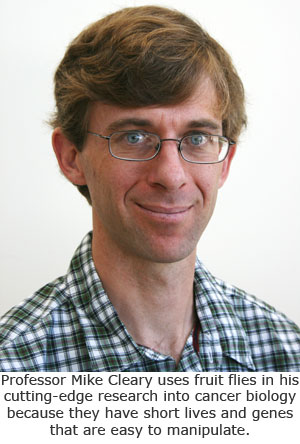

Fruit flies, with a short lives and genes that are easy to manipulate, make excellent models for innovative research into cancer.
Natural SciencesProfessor
Mike Cleary, a member of UC Merced’s
stem cellconsortium, is using these tiny bugs, formally known as Drosophila, in his cutting-edge work in cancer biology. Many of the genes that cause disease in humans have an equivalent gene in the genetic code of fruit flies. His work represents the campus’ mission to pursue innovative solutions to major health issues.
Cleary is studying their neural stem cells, called neuroblasts, as a model for stem cell self-renewal and differentiation. Neuroblasts produce the diversity of cells types found in the nervous system.
Stem cells are undifferentiated cells that are capable of dividing and creating new cells.
Most of the time, stem cells are creating healthy cells for a person’s body. However, they can start creating the wrong cells, causing cancer to develop. Increasingly, research suggests altered gene expression can cause stem cells to become cancerous. Researchers are still working to understand the behavior of stem cells and how they make self-renewal versus differentiation choices.
Fruit flies’ short lifespan and rapid reproduction allows researchers to quickly see how gene manipulations affect the fly’s development, Cleary said. Experiments involving mice can take up to six months.
Over-expressing or removing genes can cause mutations and large numbers of flies with different mutations can then be screened for brain defects, such as overproliferation of neuroblasts (causing brain tumors) or decreased proliferation (causing under-developed brains).
Understanding the regulation of neuroblast proliferation will likely be beneficial for preventing and combating cancer, Cleary explained.
“It could hopefully provide a target for human therapies,” he noted.
Cleary did his undergraduate studies at UC Davis and was a graduate student at Stanford University. He said the University of California is the best public university system so he was eager to apply for an opening at UC Merced.
He praised the graduate and undergraduate students working in his lab for taking charge of the research.
“They’re doing a great job,” he said. “It gets easier as the lab becomes more self-sufficient.”






